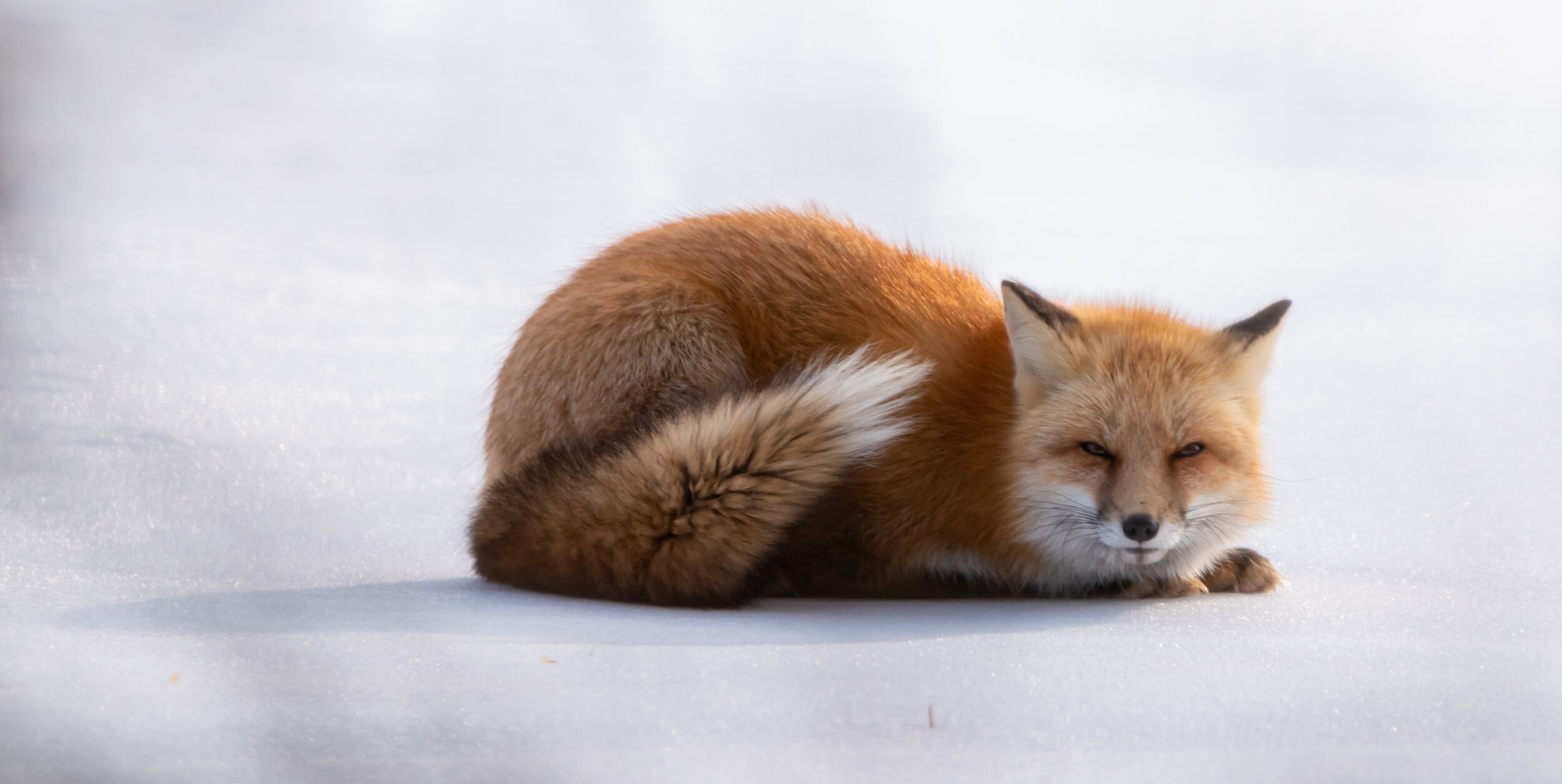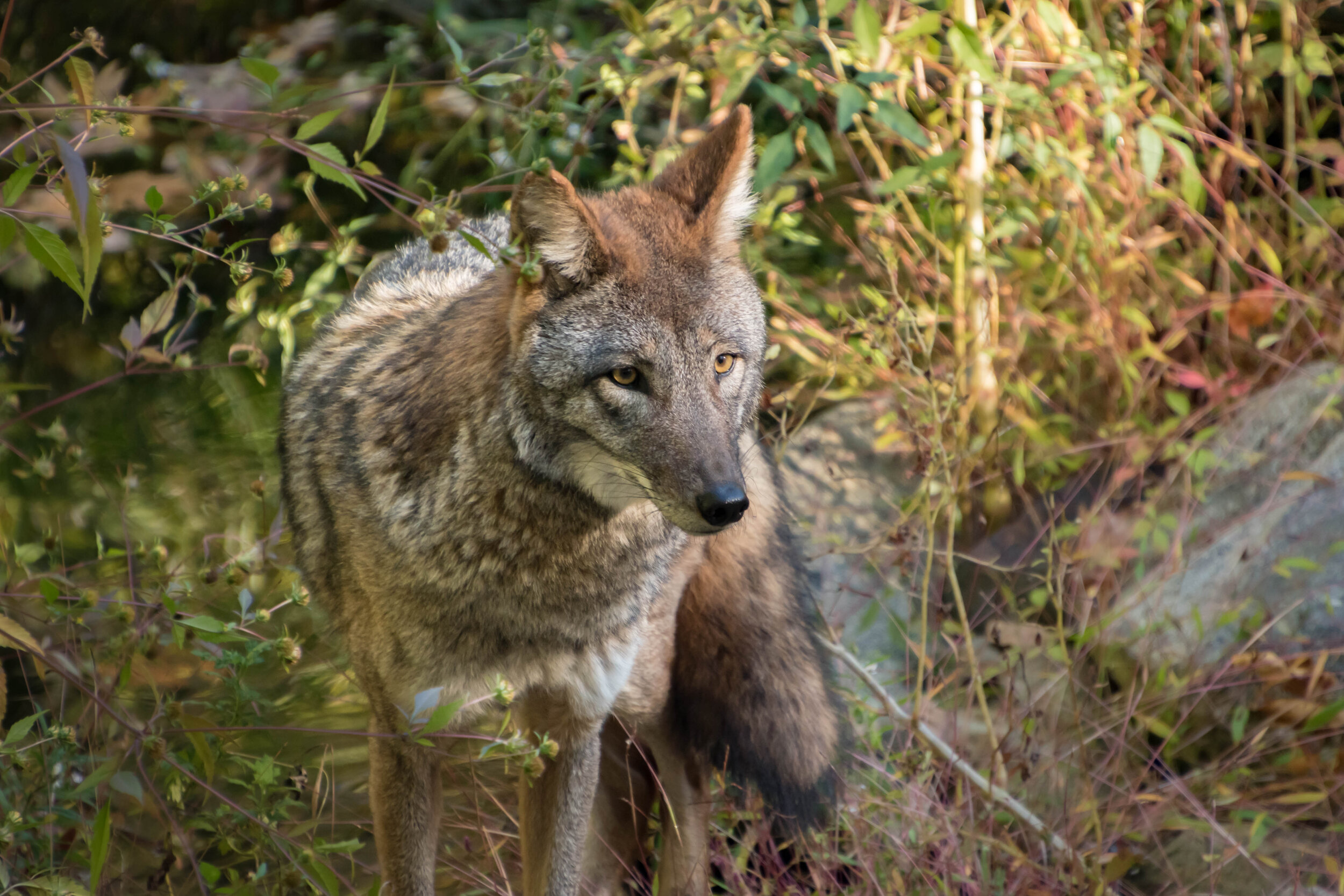Long Island Canines: The Native (Red Fox) and the Newcomer (Coyote)
Featuring Photography from Garrett Camasi (@creaturecatalog)
Written by Rich Nardo
Photos by Garrett Camasi
The past century has seen the coyote embark on a cross country journey that rivals any arena tour or epic adventure. Traditionally a resident of the western and central United States, the clearing of forests by humans and persecution from larger predators has encouraged the species to expand their territory throughout the entire continental US and southern Canada. During that time, only one land mass in that entire region has withstood their advances…good ole Long Island.
Over the past decade, coyotes have began to conquer their final frontier here on the Island. While much is being made in the news about their expansion, this newcomer is not the only wild member of the canine family to call Long Island home. The red fox (and the elusive gray fox) have made their home here for as long as humans have. With no other large predator around, the red fox plays an integral role in our ecosystem and it will be interesting to see how their role evolves now that their larger cousins are moving into the neighborhood.
For this article, we’ll be taking a look at Long Island’s native ‘top dog’ and the newest species to settle here. We are very lucky to have the amazing photography of Garrett Camasi (@creaturecatalog) to provide a visual accompaniment to their story. Garrett is a naturalist and photographer whose mission is to document and educate people about the incredible biodiversity on Earth and the significance of healthy wildlife in functioning ecosystems. He’s worked in veterinary hospitals and zoos in different countries for the past seven years and now we get the honor of featuring his photography on ntvli.com. You can follow his work on Instagram and Facebook and donate here to help him on his incredibly important mission!
The Newcomer
Get to Know the Eastern Coyote
DISCLAIMER: This photo was not taken on Long Island.
The eastern coyote is significantly larger than its counterpart inhabiting the deserts and plains out west. They can reach sizes of up to 60 pounds (as opposed to the traditional range of 20-40 pounds), and it’s believed that these bigger ‘yotes are the result of interbreeding with gray wolves and domestic dogs as they made their way east. Coyotes tend to live in out-of-the-way places and are active at night, so human interactions are somewhat rare as these highly adaptable apex predators survive on a diet that includes everything from fruits and insects to small animals like rats, rabbits, or squirrels.
Wondering if you saw a coyote or a domestic dog on the loose? There are several ways to tell the difference. Coyotes have long thick fur, full bushy tails, and large pointed ears. You can look for a black tip on their tails and dark scent glands where the tail joins the hindquarters. Also their tail will almost always hang straight down.
The Coyote’s Journey to Long Island
Coyotes are abundant upstate, with an estimated population of over 30,000 according to the New York Department of Environmental Conservation. Coyotes first showed up in New York State in the 1920s, and were believed to be a coyote-dog hybrid which was often called the coy-dog. By the 30s and 40s, they had spread across most of the state and by the 70s they were firmly established within the ecosystem. Thanks to advancements in DNA testing over the years, we can now confirm that the eastern coyote is, in fact, a hybrid. Their genetic make-up is believed to consist of western coyote (62%), western wolf (14%), eastern wolf (13%) and domestic dog (11%).
Long Island’s coyotes are believed to have come from the Bronx, either by swimming or walking on aqueducts to Queens. It’s not known exactly when the first coyote ventured onto Long Island, but scientists believe that it may be as far back as 2005. The first ‘official’ sighting came in Bridgehampton on June 24, 2013 when the DEC confirmed the presence of a solitary coyote photographed by a potato farmer on his property. Over the years, coyotes have been spotted regularly by golfers and farmers on both the north and south fork. They’ve also been spotted randomly in other parts of Long Island, including Robert Moses State Park about 10 months ago. The first litter ever born on Long Island was in a woodlot near Laguardia Airport in 2016, and a ‘well fed’ coyote was also photographed chilling on the roof of the the LIC Bar in Long Island City back in 2015.
Today there are at least nine coyotes spread across Long Island. More notably, there are several mating pairs living in northern Queens and Nassau County. One couple lives in a Nassau municipal park and the other lives on an estate in northwest Nassau County - the exact locations are not being revealed in order to protect their dens. With this development, we’re only a few short years away from the coyote being officially established on Long Island.
DISCLAIMER: This photo was not taken on Long Island.
Will Coyotes Help or Hurt the Long Island Ecosystem?
The short answer is that they will most likely help it. Right now, we’re experiencing an overabundance of white tailed deer which, in turn, has caused an increase in diseases like Lyme Disease that are carried by ticks. The deer are also threatening the long-term viability of forest ecosystems according to the NYSDEC. For example, we’ve lost a lot of native orchids, such as the now rare pink ladies slippers, since the deer population has risen. Coyotes will help Long Island’s deer issue by preying on their fawn. Coyote also prey on feral cats that are having a devastating impact on backyard birds and small animals. Finally, they will eat roadkill, helping to remove disease-carrying carrion.
Adjusting to Life on Long Island
Coyotes tend to avoid people, but they can see pets (especially outdoor cats) as prey. There are several things that we can do to ensure a healthy relationship with our new neighbors as they become more prevalent. Most significantly, do not create food sources for them by your home or business. Studies show they prefer a natural diet (i.e rodents, rabbits, plants, insects), but they are opportunistic and will take advantage of unsecured trash left out or unattended pets.
If you do happen to encounter a coyote that seems a bit bold, make sure you stand tall, shout at them if they seem to be approaching, and if that doesn’t deter them, throw objects in their direction. Under no circumstances should you run, as that makes you appear as prey as opposed to a potential fight that wouldn’t be worth their efforts. This kind of behavior will help them learn their boundaries and keep an appropriate relationship to any coyotes living in your area.
DISCLAIMER: This photo was not taken on Long Island
The Native
Get To Know the Red Fox
A red fox springing through the woods or coastal dunes of Long Island is a remarkable sight to behold. They are the largest, and most abundant, of the true foxes but are still relatively small at eight to fifteen pounds and 34-44 inches from head to bushy tail (which is half their body length!). Red foxes are highly adaptive, much like the coyote, and have seen their range greatly increase alongside human expansion.
Red foxes can come in many different color morphs, but on Long Island we mostly see the iconic orange-red variation with black legs and ears. The underbelly, chin, and tail tip are white and they can have black coloring on the muzzle and tail as well. Red foxes are largely nocturnal or crepuscular, which means they are most active at dawn or dusk. During the winter months, they are more inclined to hunt during the day, so do not be surprised if you see one on a winter walk. When it comes to breeding, red foxes form long-term pair bonds and both parents care for their kits, which are born in underground dens from spring until fall. The males will generally spread out into new territories once old enough, but the females of each litter will often stay around the den and help with the next batch of pups to be born.
Foxes generally excavate the dens of smaller animals and enlarge them to fit the family. A red fox family usually consists of a dominant pair and younger relatives who assist in hunting and guarding the den. Eventually these younger foxes will move on and start their own territories. Foxes communicate using a series of varying calls or by signaling with their tails. Those exquisite, bushy tails also aid in balance and to help keep warm in the winter.
The red fox is famous for their cunningness, hence the phrase ‘sly fox’. They stealthily stalk their prey and often deliver their final strike via a nearly vertical leap allowing for an attack from above. Their omnivorous diet consists of fruit, berries, insects, rabbits, birds, rodents, and reptiles. They’ll often hunt even when not hungry, and store their kill underground for a later time when the meals are less prevalent.
Long Island Reds and our other Native Fox
According to the National Wildlife Federation, foxes are the most widely distributed carnivorous mammals in the world. Thanks in large part to the lack of natural predators and an abundance of food sources, the red fox population is on the rise on Long Island. They are returning to areas like Shelter Island where they’ve been absent of late and finding new homes in places like Norman J Levy Preserve in Merrick. As lovable as foxes are, they do cause a bit of a problem for Long Islanders who keep chickens - a favorite feast of our little red friends - leading to another famous turn of phrase ‘a fox guarding the henhouse’.
The red fox’s smaller cousin, the gray fox, can also be found on Long Island albeit in a much smaller capacity. As their name implies, they are generally gray in color with some reddish patches reminiscent of their larger Long Island fox neighbors. The gray fox is known for being more feline-like than the red fox and are agile climbers. Unfortunately, while the red fox has thrived with human expansion, the shrinking of their natural habitat has caused a reduction in the population of gray foxes who are easily outcompeted for food by their larger cousins.
Threats to the Red Fox on Long Island
While the numbers are currently surging, there are several threats to Long Island’s red fox population. Fox populations naturally eb and flow, but there are multiple factors occurring on the Island at the moment that indicate we could see a downturn in fox sightings. Chief among them is the proliferation of the mites that cause the highly contagious disease, mange. After burrowing into their skin, mites cause severe irritation, skin thickening, infection and hair loss; creating a scenario where a fox can become too sick to hunt. This obviously affected the individual, but it can also devastate litters dependent on their parents for food.
Human landscape development is also a hindrance to the fox population despite their adaptability. As we expand communities, we force Long Island’s red foxes into smaller and smaller ranges. We also fragment their territory with roads and areas designated for commercial and residential areas, which is causing a troubling lack of genetic variation. Foxes are also regularly hit by cars, poisoned, or attacked by larger domestic dogs.
That brings us to a new threat to the red fox, our featured newcomer, the coyote. While foxes occur naturally on Long Island, one reason that the population is believed to be so high here is that the expanding number of coyotes in upstate New York pushed foxes to Long Island. Coyotes are the fox’s main predator, so as they continue to settle on the Island, fox numbers could decline.
It is incredibly important for humans to keep an eye on any decline in our fox population. Much in the way Long Island coyotes could help us combat Lyme disease by preying on deer, foxes favorite prey is another primary carrier of lyme disease, rodents.
Long Island has a lot to gain from having two apex predators at the top of our ecosystem - the red fox and the coyote. We should embrace both species and make sure we create an environment where they can succeed while monitoring numbers to ensure they stay in the healthy range of population. This is a great example of why Garrett’s work in educating the public to the needs of wildlife in their backyard is so important. If you enjoyed his photography, make sure to follow him on Instagram, visit his website, or donate to his work.
Resources
https://www.newsday.com/opinion/commentary/enrico-nardone-coyotes-long-island-habitat-1.49215902
https://www.newsday.com/long-island/environment/coyotes-living-in-nassau-county-1.50079807
https://www.fox5ny.com/news/officials-issue-alert-as-coyotes-make-new-home-on-long-island
https://sayville.greaterlongisland.com/2020/12/06/longislandcoyotes/
https://seatuck.org/coyote-tracker/
https://sbpress.com/2020/02/long-islands-next-local-the-coyote/
https://www.dec.ny.gov/animals/9359.html
https://fishersisland.net/long-island-coyote-update/
https://abc7ny.com/coyote-pets-dogs-cats/3818329/
https://qns.com/2015/03/coyote-discovered-on-roof-of-long-island-city-bar/
https://patch.com/new-york/kingspark/bp--red-foxes-kings-parks-wild-canines
https://www.longislandgamefarm.com/our-animals/red-foxes-long-island-zoo/
https://shelterislandreporter.timesreview.com/2018/04/12/return-red-fox-shelter-island/
https://longisland.news12.com/red-foxes-on-the-move-in-west-islip-34748915
https://www.inaturalist.org/guide_taxa/478102
https://www.nps.gov/fiis/learn/nature/red-fox.htm
https://www.montauksun.com/wildlife-in-winter/
https://www.lisierraclub.org/post/the-future-of-fox-coyote-populations-on-long-island




















Ask any wildlife photographer or explore based on Long Island and they’ll tell you that our home turf does not get nearly the credit it deserves when it comes to species diversity. In fact, I think it’s safe to say that most people think Long Island has a couple of raccoons, a possum here and there, and way too many deer out east and that basically sums it up.
This couldn’t be further from the truth. So for this article, we worked with some of the best wildlife photographers based on Long Island to highlight 10 species that most people might not know we have here.